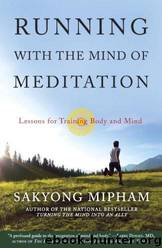Running With the Mind of Meditation: Lessons for Training Body and Mind by Sakyong Mipham Rinpoche

Author:Sakyong Mipham Rinpoche
Language: eng
Format: mobi, epub
Tags: Health & Fitness, Meditations, Running & Jogging, Sports & Recreation, General, Religion
ISBN: 9780307888181
Publisher: Harmony
Published: 2012-04-10T00:00:00+00:00
22
Healthiness
One of the lessons of the lion is basic healthiness. In meditation, you take the approach from the beginning that the mind is fundamentally healthy and balanced; innately, it has strength and flexibility; it has the ability to love and to be kind. Because of my training, if I feel distracted or tired while I’m meditating, I know that it is not a permanent state; it is just a temporary anomaly, like clouds blocking the sun. The natural state of the mind, basic goodness, is primordial and unchanging.
Approaching meditation with this confidence in the mind’s basic goodness, I am able to regain my strength and focus. However, if I feel distracted or tired and decide my mind is hopeless—that I’ll never be calm, balanced, or sane—then the more I meditate, the more upset or depressed I might get. So even when I don’t feel great, staying in touch with my basic healthiness is a discipline I try to observe in both running and meditation.
In running, regarding yourself as basically healthy is how to avoid getting trapped in a negative state of mind, thinking you are weak or out of shape. It may be true that you cannot run five or ten miles right now, but you should recognize the fact that your healthiness is innate. Being in shape is within us, as if we were small birds ready to fly. Genetically, the bird is predisposed to flying. Likewise, we are designed to move.
My father was an inspiration in this regard. He was a great meditation master. While escaping from Tibet, he walked out of the Himalayas. Somehow that kept him fit for life. He never exercised very much, but he always approached things from the point of view of basic healthiness. Therefore, he always had a vigor and energy about him.
The lineage that I received and now hold began with the Buddha over twenty-five-hundred years ago. When we hear the Buddha’s name, a saintly individual comes to mind. He was anointed as buddha, “the awakened one,” in the sixth century BC. Having attained a state of mind in which he experienced ultimate reality, he then proceeded to teach about his experience for the next fifty years, finally passing away at the age of eighty-four.
Despite this incredible spiritual accomplishment, before his spiritual life even began, the Buddha was quite an athlete, accomplished in javelin throwing, wrestling, archery, and charioteering. He was tall, extremely handsome, and well proportioned, with “the chest of a lion and calves like an antelope,” according to tradition. In other words, he was a very athletic fellow. Thus the Buddha was quite well suited to talk about both physical and mental disciplines, as ideally one would have both these elements in one’s life. Meditation, much like running, was considered to be a good and healthy exercise—for the mind.
What meditators have known for centuries is that the mind is raw material. It’s like tofu—neutral and pliable. The mind has two basic modes of receiving experiences that alter how it feels.
Download
Running With the Mind of Meditation: Lessons for Training Body and Mind by Sakyong Mipham Rinpoche.epub
This site does not store any files on its server. We only index and link to content provided by other sites. Please contact the content providers to delete copyright contents if any and email us, we'll remove relevant links or contents immediately.
Periodization Training for Sports by Tudor Bompa(8107)
Bodyweight Strength Training by Jay Cardiello(7811)
Therapeutic Modalities for Musculoskeletal Injuries, 4E by Craig R. Denegar & Ethan Saliba & Susan Saliba(7666)
Born to Run: by Christopher McDougall(7034)
Imperfect by Sanjay Manjrekar(5752)
Wiseguy by Nicholas Pileggi(5618)
Shoe Dog by Phil Knight(5085)
Paper Towns by Green John(5035)
The Body: A Guide for Occupants by Bill Bryson(4900)
The Rules Do Not Apply by Ariel Levy(4801)
Endurance: Shackleton's Incredible Voyage by Alfred Lansing(4636)
Tuesdays with Morrie by Mitch Albom(4615)
Bodyweight Strength Training Anatomy by Bret Contreras(4583)
Yoga Anatomy by Kaminoff Leslie(4253)
The Sports Rules Book by Human Kinetics(4226)
Science and Development of Muscle Hypertrophy by Brad Schoenfeld(4065)
Dynamic Alignment Through Imagery by Eric Franklin(4056)
Machine Learning at Scale with H2O by Gregory Keys | David Whiting(3993)
Alive: The Story of the Andes Survivors by Piers Paul Read(3932)
